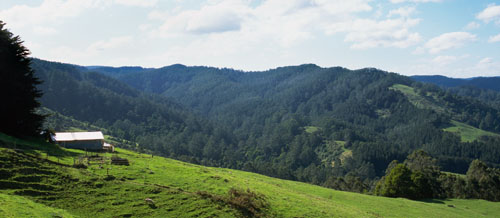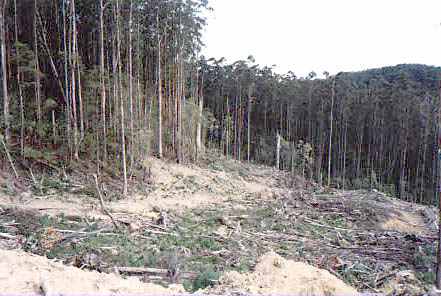
Riley's Ridge Wildlife Corridor
Riley's Ridge is a critical wildlife corridor North-West of Apollo Bay.
It links Otway National Park and adjoining State forest in the Western
Otways with the Angahook-Lorne State Park and State forest in the Eastern
Otways.
To the North of Riley's Ridge forest is the extensive Aire Valley Pine
plantation. To the South of the Riley's Ridge is cleared farmland. To
the West is the West Barham catchment an Otway National Park. To the East
is the East Barham catchment and East Otway forests.
Clearfell logging in 1999 reduced the connecting forest corridor by about one kilometre. It is estimated a remaining two-kilometre strip of forest on Riley's Ridge now forms the only remaining wildlife corridor that links the East and West Otways together.

Riley's Ridge in the background - important wildlife corridor of forest
connecting the East and West Otways.
Community Protest Action at Riley's Ridge
The West RFA placed Riley's Ridge into a
SMZ.
Flawed Reserve System for Riley's Ridge
Habitat Fragmentation
National Estate
Aesthetic/Tourist Values
Government Processes
Conclusion
Community Protest Action at Riley's Ridge
The logging schedule (Wood Utilisation Plan) for the 1998/1999 logging season showed three areas were scheduled to be clearfell logged on Riley's ridge - this would have effectively cut the Otways into half. See habitat fragmentation.
The community responded by organising numerous protest actions in January 1999 designed to draw attention to the fact Riley's Ridge was being logged. The Kennett State Government refused to negotiate with the community. Protests did not prevent logging from proceeding and a 20-hectare area was clearfell logged.

Riley's Ridge clearfell logging and remaining forest saved for now by
protest action.
Due to the eagerness of Forestry Victoria to log the area before the West RFA was signed, logging commenced in mid October 1999, early in the next logging season (1999/2000). In late October 1999, a Tree Village was set up. Again, the idea of a tree village was to draw attention to the values of Riley's Ridge.
The tree village was set up secretly while logging proceeded. When Forestry Victoria discovered the tree village and reported back to the Minister, the new State Labor government began negotiations and logging was suspended. Logging contractors were allowed to remove all trees already cut down and then were moved on to clearfell log other areas in the Otways.
The Tree Village camp at Riley's ridge remained set up for six months with people permanently camped on site. Over a thousand people visited and stayed.
For images of the Rileys Ridge tree village see outside website.
In February 2000, Forestry Victoria attempted to break up the tree village so logging could resume. They failed to remove people from the trees and a car dragon. After two days Forestry Victoria gave in when protest action in other Otway forest areas began to escalate in retaliation for the attempts to resume logging at Riley's Ridge.
There have been no physical attempts to log at Riley's Ridge since. Forest Victoria has continued to defer logging at Riley's Ridge with plans for clearfell logging in the area now scheduled for the 2003/2004 logging season.
The major outcome of the six-month Riley's Ridge Tree Village was the formal recognition from the government that Riley's Ridge is a wildlife corridor. Through the RFA process, Riley's Ridge is now incorporated inside a Tiger Quoll Special Management Zone.
Riley's Ridge is a Special Management Zone.
When the West RFA was signed in March 2000, Riley's Ridge was included within a 1000 ha Special Management Zone (SMZ) for Tiger Quoll conservation. The fact the area was included in an SMZ vindicated the claims by conservationists that the area is an important wildlife corridor and logging the ridge would initiate major habitat fragmentation in the Otways.
A report on Tiger Quolls in the Otways by Chris Belcher (Feb 2000), lists the existence of Quolls in the Otway National Park and the headwaters of the East Barham River. Riley's Ridge forms the only native forest wildlife corridor between these two known records. A deep-forested valley still exists on Riley's Ridge is now the last passage for Tiger Quolls via a saddle. The Chris Belcher report has a record of a Quoll being present on Riley's Ridge in the late 1990's.
For more info on Chris Belcher report.
Before logging can commence within an SMZ, a SMZ Plan must be drawn up. This has not yet been none for Riley's Ridge area and is one of the main reasons logging has been deferred.
For more information on SMZ plans.
See map of Riley's Ridge showing Management Zones.
Flawed Reserve System for Riley's Ridge
The final RFA so called Comprehensive Adequate and Representative (CAR) Reserve System, shows a 200 metre wide SPZ wildlife corridor on the southern end of Riley's Ridge. This corridor follows the boundary of existing fence lines and cleared private land. The proposed corridor is the same as the existing reserve provided in the Otway Forest Management Plan.
See map of Riley's Ridge showing Management Zones.
The West RFA has yet to provided scientific justification to demonstrate that the location and width of the existing wildlife corridor is adequate or appropriate to protect Tiger Quoll habitat from fragmentation.
Habitat Fragmentation
In December 2000 (after the West RFA was signed), Habitat Fragmentation as a threatening process was added to the Flora and Flora Guarantee Act. It is anticipated that an Action Statement for Habitat Fragmentation will provide the prescriptions to protect Riley's Ridge from logging practices.
National Estate
A CRA report titled The National Estate Identification and Assessment in the West Region of Victoriaidentifies the Barham Catchment, which includes Riley's Ridge as having high natural landscape values.
Aesthetic/Tourist Values
Riley's Ridge can be seen from the Great Ocean Road about half way between Apollo Bay and the Otway National Park. Lookouts along the Great Ocean Road used by tourists look out across Riley's Ridge. Proposed logging will impact on aesthetic and scenic values relied on by the regional tourist industry.
Additionally, residents who live in Paradise Valley and Killalla will also experience deterioration of scenic values if logging proceeds.
Back in 1978 the Land Conservation Council recommended that scenic landscape values of the Great Ocean Road between Apollo Bay and Cape Horn (near the boundry of the Otway National Park) need to be protected. See LCC 1978(c).
However since 1978, the scenic and aesthetic values of Riley's Ridge have never been properly assessed in either the Otway Forest Management Plan or the West Regional Forest Agreement.
For more information see scenic & aesthetic values of the Otways.
Government Processes.
The State Government has failed to properly assess and protect Riley's Ridge. Government processes designed to protect values have been slow and not completed. These include:
- delays in releasing Action Statement for Tiger Quolls has not been competed
- no SMZ Plans
- Action Statement for Habitat Fragmentation not completed
- Aesthetic values not addressed.
The campaign to protect Riley's Ridge now focuses on lobbying the State Government to follow through with processes and further research that the government has committed to complete.
The State Government's own processes to date make it obvious that Riley's Ridge should be permanently protected as a wildlife corridor and incorporated into an extension of the Otway National Park.
However the native forest woodchip industry is lobbying the State government to ignore process and research so logging can restart in the area.
Conclusion
There have been a reprieve from logging at Riley's Ridge but the area is still far from protected.
Relevant Links
See more photos of Riley's Ridge on another website.
Don't know the meaning of a word? Check the glossary.